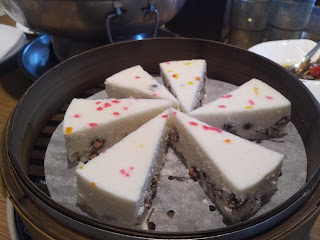While the Supera/Signet Tours (
www.superatours.com) promotional materials use the catch phrase "food=life" I was anxious to see if the tour would actually live up to the promise. Well Supera Tours showed that they really meant business when they took us to lunch for the first official meal of the tour at the original location of Din Tai Fung in downtown Taipei.
Now Los Angeles area diners have been familiar with Din Tai Fung and their signature xiaolongbao, their open kitchen where you could watch the XLB being made, and other goodies created in the kitchen for 20 years now, ever since they opened up in Arcadia in the San Gabriel Valley. It did not take long for that restaurant to reach cult status, and Din Tai Fung was the toughest Chinese restaurant ticket in town, as people lined up outside the restaurant daily before opening, or experienced extended waits during the day. Despite everything, Din Tai Fung refused to expand beyond their relatively small Arcadia store. Their fame spread far and wide across the United States. A week long pop-up in Flushing, New York Chinatown was sold out, leading New Yorkers to believe that they were in for their own branch of Din Tai Fung, but that didn't happen. Heavy rumors said that Din Tai Fung was going to open up in the Vallco Mall in Cupertino in California's Silicon Valley, but that did not come to pass either. (Ironically years later, Apple opened their Apple II headquarters just up the street.)
Word on the street was that Din Tai Fung had an in-house astrologer that nixed most expansion plans. The only expansion activities that Din Tai Fung did engage in was a second Arcadia branch, two doors down from the original, and two locations in Seattle, where some family members had moved. But then a half dozen years ago, Din Tai Fung did a 180° turn. Not only did they go on an expansion tear, but all of their new locations were in major regional shopping malls with hundreds of seats. Since then they have opened up in the Americana in Glendale, South Coast Plaza in Costa Mesa, Westfield Santa Anita in Arcadia, Del Amo Fashion Square in Torrance and Westfield Century City in Los Angeles, in the San Francisco Bay Area, Valley Fair in Santa Clara, and Washington Square in Portland, OR. And the funny thing is with all this extra capacity, you still have a long wait to eat in the restaurant.
While all of the Din Tai Fung US locations are highly regarded, I have always heard that the original Taipei location was clearly superior to all the US and other overseas locations. Consequently, I was looking forward to making the comparison. Despite the fact that we arrived before 11:30am and were part of a tour, we had to wait nearly a half hour before being admitted to the restaurant.
When we finally got in we were broken up into four different groups on different floors. First up was the cucumber salad, an excellent version.
Of course, Din Tai Fung sets the standard for xiaolongbao.
But I've never had on choy at a Din Tai Fung before.
Nor hot and sour soup.
Something interesting were these hui tou dumplings. These dumplings are upside down to show that they were cooked slurry style so that the bottoms meld into a single piece.
This may not look like it, but here is the definite star of the show--truffle xiaolongbao. Wow!
A really nice dish was pork siu mai with sticky rice. My mom used to call siu mai "stacks" because they looked like a haystack way back when in Los Angeles. These babies certainly do.
Another interesting item--they may look like regular XLB to you, but these were filled with squash. Creative and delicious.
A special off menu item for our group was the fried rice. People who have eaten at the Los Angeles area branches of Din Tai Fung know they make the best fried rice in town, and this did not disappoint.
And what are these XLB with a dark filling? Why, taro. I've had these in Los Angeles
And lastly and leastly, chocolate buns. Perhaps not the best idea.
All in all, this was an excellent meal. Indeed some of the tour members not from Los Angeles went on their own to eat at other branches of Din Tai Fung. But while the original Din Tai Fung is indeed better than what we get in California, I would say just incrementally so. Which is fine with me knowing that our branches of Din Tai Fung are nearly as good as the flagship location.
























































